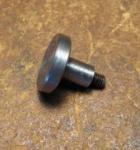If you're going to use my technique for centering work in the 4jaw...
http://www.homemadetools.net/forum/c...aw-chuck-27241
it's a good idea to have what I'll call an "elephant foot" tip on the dial indicator. This way you don't need to worry about having the DI axis exactly in the plane of the lathe axis.
I had been using the baby elephant foot from a set of points I bought, something like these...
https://www.amazon.com/T%C3%9CRLEN-P...dicator+points
but it was required in another application so I had to make an adult foot to replace it.
Normally I would turn a 0.112" stub on a piece of steel and use my 4-48 die to thread it. However, my die seems hopelessly dull so, until I can sharpen it or buy a replacement, a different approach is required.
I turned a 3/16 stub 1/4" long on a bit of 1/2" steel. Then I drilled the stub #42 (0.0935") and tapped it 4-48 with a good tap, followed by a bottoming tap I'd made from another 4-48 tap. I then threaded a 4-48 screw with some Loctite 609 on it into this threaded hole. Cut the screw to length with a jeweler's saw and deburred with a Dremel sanding disk. Voila, an elephant foot for my DI.
Two remarks here...
This approach to creating the threaded stub actually has two advantages over using a die. The threads automatically extend right up to the end of the foot so it can seat flat against the end of the DI probe; there's no need to undercut the thread next to the foot. Also, it's a more economical approach for folks on a budget who might not want to spend the money for a die they'll only use rarely.
The elephant foot can serve in lieu of my flapper, shown here with my older DI mount...
http://www.homemadetools.net/forum/c...al-stock-27183
when working with small diameter polygonal stock.


 LinkBack URL
LinkBack URL About LinkBacks
About LinkBacks




 Reply With Quote
Reply With Quote

 . Just made a shallow hollowing tool for a wood working guru friend and he's way happy...now the hard compound bend ones and why the interest in your bender.
. Just made a shallow hollowing tool for a wood working guru friend and he's way happy...now the hard compound bend ones and why the interest in your bender.



Bookmarks